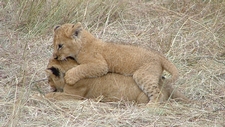Learned and Instinctive Behaviors

TEKS Objective
The student is expected to explore that some characteristics of organisms are inherited such as the number of limbs on an animal or flower color and recognize that some behaviors are learned in response to living in a certain environment such as animals using tools to get food.
Essential Understanding
The student knows that organisms undergo similar life processes and have structures that help them survive within their environments.
Science Background
Instincts and Learned Behavior: BBC Science and Nature (website) - Adaptations, whether anatomical, behavioral or physiological, help organisms to survive in diverse ecological niches or habitats. Navigate this website for extensive information and excellent photographs focused on animal adaptation, behavior, communication and more.
Instincts and Learned Behavior
BBC Science and Nature, www.bbc.co.uk/nature
Basic Animal Behavior in Domesticated Animals: Yale University (website) - Detailed information on learned and inherited behaviors among animals, followed by lesson ideas that might be adapted for use in elementary classrooms.
Basic Animal Behavior in Domesticated Animals
Yale University, www.yale.edu
Signature Lesson
Observing Fish Behavior: Sea World (website) - Engage students in explore animal behavior by observing fish in an aquarium for short periods of time. Have students distinguish between behaviors that appear instinctive (such as swimming in schools) and those that might be learned (for example, anticipating feeding times).
Observing Fish Behavior
Sea World, www.seaworld.org
Pets, Oh Behave: Science NetLinks (website) - Students learn that a variety of factors (species-specific traits, environment, training and experience) affect pets’ inherited and learned behavior, and that animals’ capacity to learn varies from species to species, and also within individual species.
- Supporting Lessons
- Extensions
- Assessment Ideas
- Literature Connections
- Related
TEKS - Additional Resources
Supporting Lessons
Animal Instincts: Discovery (website) - Students understand the difference between instinct and learned behavior, how instincts and behaviors help animals to survive, and the environment’s role in influencing behavior.
Animal Instincts
Discovery, www.discoveryeducation.com
Understanding by Design: Trinity University (PDF) - Students investigate and learn about innate and learned characteristics in animals and humans through a series of teacher- and student-led discussions, readings, reflections, hands-on activities, and demonstrations. Includes complete lesson plans, student sheets and more.
Elaboration Lessons and Extensions
Twins, Comparing Behaviors… Instinct v. Learned Behavior: Utah Educational Network (website) - Engage students in discussion and exploration of the differences between learned and instinctive behaviors. Includes extensions and assessment.
Twins, Comparing Behaviors… Instinct v. Learned Behavior
Utah Educational Network, www.uen.org
Assessment Ideas
Have each student draw the outline of a fish on a blank piece of paper or in his/her science notebook. Then, instruct students to add written descriptions of at least four different behaviors they observed among fish at the aquarium (see Signature Lesson).
Literature Connections
Good Dog! Kids Teach Kids About Dog Behavior and Training. Pang, Evelyn (ISBN-13: 978-1929242580)
The Forest Friends Learn to Be Kind. Dobson, Danae (ISBN-13: 978-0849910166)
Where Are Your Manners? Underwood, Deborah (ISBN-13: 978-1410925947)
The Mysteries of Animal Intelligence. Steiger, Brad (ISBN-13: 978-0765357489)
Who Was Charles Darwin? Hopkinson, Deborah (ISBN-13: 978-0448437644)
Would You Survive? Townsend, John (ISBN-13: 978-1410919694)
Additional Resources
Animal Behaviors and Training: Sea World (PDF) - Standards-aligned teacher guide that integrates science, mathematics, social studies and language to help students learn about animal behavior and how professionals at SeaWorld train animals. Includes a full series of lessons, teacher background, student pages and more.
Animal Behaviors and Training
Sea World Busch Gardens, www.swbg-animals.org
The Right Way to Train A Dog: PBS (website) - Through training, dogs can learn new behaviors and skills. This website provides some basics about dog training and behavior. (Click “next” at the bottom of each page for information about teaching different skills.)
TEKS Navigation
Grade 3
Need Assistance?
If you need help or have a question please use the links below to help resolve your problem.

Comments